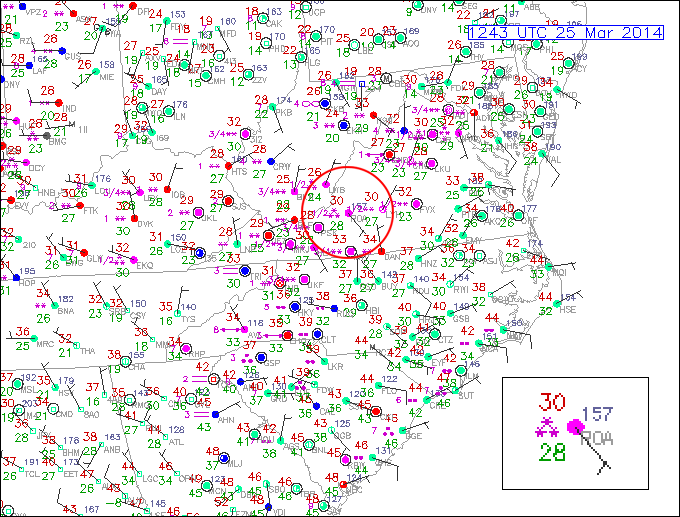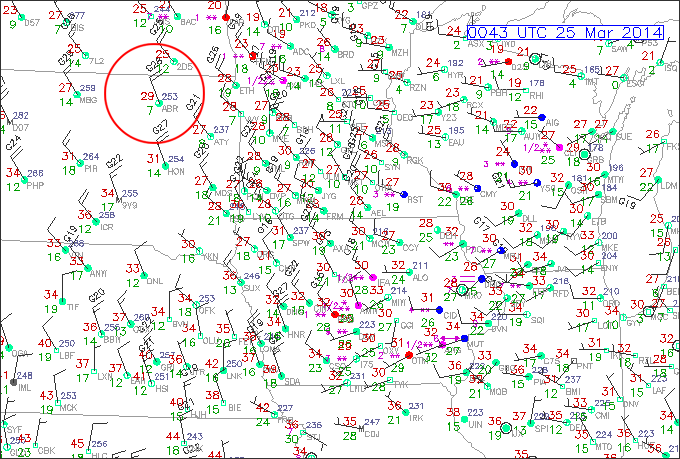-
Consider this surface station model plot from 1243Z on March 25, 2014.

Now answer the following questions:
- What is the local time and date in Virginia that these observations were collected (note: Daylight Saving Time is in effect)?
Virginia lies in the Eastern Time Zone which is usually (UTC -5). However, because of Daylight Saving Time, Virginia is now UTC-4. Therefore, 1243Z translates to 8:43 a.m. EDT on March 25. Note: It is incorrect to say 8:43Z or 8:43 UTC because you are converting to local time.
- Focus your attention on the Roanoke, Virginia (ROA). I have circled the station in red and placed an enlarged copy of the station model in an inset box. What is the station's temperature and dew point temperature at this time (proper units are a must)?
The temperature is 30 degrees F and the dew point temperature is 28 degrees F.
- What is the wind direction (in degrees) and wind speed at ROA? Again, don't forgot proper units.
The wind direction is FROM the southeast or 135 degrees. The wind speed is 5 knots (note: not miles per hour).
- Use this link to the interactive station model tool to decode the three stars located to the left of the station model.
The three stars means that moderate, steady snowfall was being recorded at the time of the observation
- BONUS: Note the station directly south of ROA (but still inside the red circle). Something is strange about this observation.... can you spot the seeming inconsistency?
At this station, light snow was being recorded but the temperature was above freezing (33 F). Believe it or not, this is not all that rare of an event. Snow can be observed when the air temperature is as high as several degrees above freezing. This occurs when there is a very shallow layer of warm air near the surface, while the air higher up is below freezing. The snow is actually melting in the warm air, but the snowflakes don't immediately melt, thus giving you snow when the air temperature is above freezing.
- What is the local time and date in Virginia that these observations were collected (note: Daylight Saving Time is in effect)?
-
You are given a portion of the surface observations from the upper Midwest at 0043Z on March 25, 2014.

Now answer the following questions:
- Focus on the station of Aberdeen, South Dakota (ABR) circled in red. What is the local time at this station when these observations were valid? (note: Daylight Saving Time is in effect)?
Aberdeen, SD lies in the Central Time Zone which is usually (UTC -6). However, because of Daylight Saving Time, Aberdeen is now UTC-5. Therefore, 0043Z translates to 7:43 p.m. CDT on March 24. Note that we have to subtract a day because we crossed the midnight delimiter as we traveled westward.
- What is the station's temperature and dew point temperature at this time (proper units are a must)?
The temperature is 29 degrees F and the dew point temperature is 7 degrees F.
- Do the observations indicate that the air is dry or moist? Please explain.
Given that the dew point temperature was only 7 degrees, this means that the air was very dry. Remember that the dew point temperature is a proxy for the amount of water vapor in the air.
- What is the wind direction (in degrees) and wind speed at ABR? Again, don't forgot proper units.
The wind direction is FROM the north-northwest or 330 degrees. The wind speed is 20 knots. Note that the "G28" at the end of the wind flag means that the maximum wind gust in the last hour was 28 knots.
- BONUS: Notice the station MUT (which stands for Muscatine, Iowa). This station is located right on the Iowa/Illinois boarder. The current weather symbol is a line with an arrowhead on either end. Do some research online to determine the type of weather being observed at this station. Here is a close-up of the station.
That symbol stands for ice needles. Needles are a form of snow flake that are not the traditional six-sided dendrite. They look just like needles and usually occur when the temperatures are warm (note that the surface temperture is 34 degrees F). Here's a photograph of some needles.
- Focus on the station of Aberdeen, South Dakota (ABR) circled in red. What is the local time at this station when these observations were valid? (note: Daylight Saving Time is in effect)?